
January 17, 2007

When this baby Sri Lankan slender loris is all grown up, it won’t be more than 5 inches long. But it’ll have huge night vision eyes.
The Zoological Society of London has created an amazing list of the world’s top 100 rarest and thus most endangered mammalian species.
"We are focusing on EDGE species — that means they are Evolutionarily Distinct and Globally Endangered," announced the Zoological Society of London ‘s Jonathan Baillie. "These are one-of-a-kind species. If they are lost there is nothing similar to them left on the planet. It would be a bit like the art world losing the Mona Lisa — they are simply irreplaceable."
Visit their website and their zoo for more detailed information, more photographs, to learn what mammals can be seen live, and to join the conservation effort to save these species. Needless to say, many of these mammals have already joined the ranks of being cryptic.
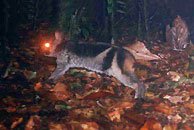
Several of these animals are former cryptids. For example, the Sumatran rabbit (pictured above and #10 below) I discussed as an "animal of recent cryptozoological discovery" in Fortean Times 128.
Here are the ZSL’s 100 mammals in trouble. The ZSL is to be congratulated for assembling such a comprehensive zoological listing:
100 Species

1. Yangtze River dolphin (Lipotes vexillifer)
CRITICALLY ENDANGERED
Long considered the world’s rarest and most threatened cetacean, this species may already be extinct.

2. Long-beaked echidna (Zaglossus bruijni)
ENDANGERED
One of the most primitive mammals on the planet, this species lays eggs like a reptile.
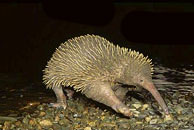
3. Riverine rabbit (Bunolagus monticularis)
CRITICALLY ENDANGERED
This ancient rabbit is one of South Africa’s rarest and most endangered mammal species.

4. Cuban solenodon (Solenodon cubanus)
ENDANGERED
This primitive insectivore was believed to be extinct until its rediscovery in 2003.
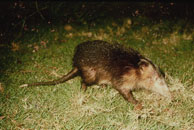
5. Hispaniolan solenodon (Solenodon paradoxus)
ENDANGERED
This ancient insectivore has modified incisors which enable it to inject venom into its prey like a snake.
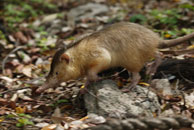
6. Sumatran rhinoceros (Dicerorhinus sumatrensis)
CRITICALLY ENDANGERED
This two-horned rhino is the smallest and most endangered of the five living rhinoceros species.

7. Black rhinoceros (Diceros bicornis)
CRITICALLY ENDANGERED
This two-horned African rhinoceros has suffered more persecution than any other species of rhino.
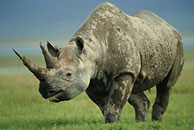
8. Bactrian camel (Camelus bactrianus)
CRITICALLY ENDANGERED
Fewer than 1,000 of these two-humped camels survive today in one of the most hostile regions on earth.
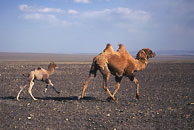
9. Northern hairy-nosed wombat (Lasiorhinus krefftii)
CRITICALLY ENDANGERED
This heavily-built marsupial is the largest known herbivorous burrowing mammal.
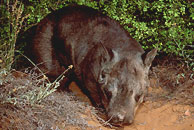
10. Sumatran rabbit (Nesolagus netscheri)
CRITICALLY ENDANGERED
This shy nocturnal mammal is so rare and cryptic that local people do not even have a name for it.

11. Javan rhinoceros (Rhinoceros sondaicus)
CRITICALLY ENDANGERED
With fewer than 60 individuals remaining, this is the rarest of all the living rhinoceros species.
12. Asian elephant (Elephas maximus)
ENDANGERED
Asia’s largest mammal, this ‘keystone’ species plays a vital role in maintaining its forest ecosystem.
13. African wild ass (Equus asinus)
CRITICALLY ENDANGERED
Domestic donkeys are now found all over the world, yet only a few hundred of their wild ancestors survive.
14. Onager (Equus onager)
CRITICALLY ENDANGERED
The onager is the swiftest of all the equids. It has been recorded running at speeds of up to 70 km/h.
15. Vietnam leaf-nosed bat (Paracoelops megalotis)
CRITICALLY ENDANGERED
This large-eared bat is known from only a single specimen. It may already be extinct.
16. Aye-aye (Daubentonia madagascariensis)
ENDANGERED
The highly distinctive aye-aye is one of the most bizarre looking animals on the planet.
17. Japanese dormouse (Glirulus japonicus)
ENDANGERED
With a thick, bushy tail and a dark stripe on its back, this dormouse resembles a miniature chipmunk.
18. Giant panda (Ailuropoda melanoleuca)
ENDANGERED
The charismatic giant panda is the world’s best known flagship species for conservation.
19. Red panda (Ailurus fulgens)
ENDANGERED
The scientific name of this rare and beautiful species literally means ‘fire-coloured cat’.
20. Wroughton’s free-tailed bat (Otomops wroughtoni)
CRITICALLY ENDANGERED
The tail projects far beyond the free edge of the tail membrane, hence the common name “free-tailed bat”.
21. Pygmy hippopotamus (Hexaprotodon liberiensis)
ENDANGERED
This species secretes oils known as "blood-sweat" which keep its skin waterproof.

22. Slender loris (Loris tardigradus)
ENDANGERED
The tears of the slender loris are used in traditional medicine.

23. Golden bamboo lemur (Hapalemur aureus)
CRITICALLY ENDANGERED
Every day this lemur consumes the equivalent of 12 times the lethal dose of cyanide for most mammals!
24. Greater bamboo lemur (Hapalemur simus)
CRITICALLY ENDANGERED
The largest of the bamboo lemurs, this species can be identified by its distinctive white ear tufts.
25. Seychelles sheath-tailed bat (Coleura seychellensis)
CRITICALLY ENDANGERED
Fewer than one hundred of these bats are thought to survive today.
26. Anderson’s mouse opossum (Marmosa andersoni)
CRITICALLY ENDANGERED
This small mouse-like marsupial is thought to be extremely rare. It is known from only two localities.
27. Mediterranean monk seal (Monachus monachus)
CRITICALLY ENDANGERED
Revered by the ancient Greeks, this shy seal is today one of the world’s most threatened marine mammals.
28. Mountain pygmy possum (Burramys parvus)
ENDANGERED
The largest of Australia’s five pygmy possums, this tiny animal can live for an incredible twelve years.
29. Golden-crowned sifaka (Propithecus tattersalli)
CRITICALLY ENDANGERED
Considered to be one of the rarest of Madagascar’s lemurs. No part of its range is protected.
30. Northern marsupial mole (Notoryctes caurinus)
ENDANGERED
This marsupial mole is more closely related to the kangaroo than it is to true moles.
31. Southern marsupial mole (Notoryctes typhlops)
ENDANGERED
Marsupial moles ‘swim’ through the sands of the deserts in which they live.
32. Puerto Rican hutia (Isolobodon portoricensis)
CRITICALLY ENDANGERED
Christopher Columbus and his crew are believed to have feasted upon this possibly extinct rodent.
33. Bulmer’s fruit bat (Aproteles bulmerae)
CRITICALLY ENDANGERED
Having been almost hunted to extinction twice, this species is one of the most endangered bats in the world.
34. Baird’s tapir (Tapirus bairdii)
ENDANGERED
This long-nosed primitive mammal resembles the ancestors of rhinos and horses.
35. Gracile mouse opossum (Gracilinanus aceramarcae)
CRITICALLY ENDANGERED
Little is known about this rare and cryptic species – only six specimens have ever been collected.
36. Indri (Indri indri)
ENDANGERED
The Malagasy people consider the indri to resemble their sacred ancestors.
37. Hirola (Damaliscus hunteri)
CRITICALLY ENDANGERED
The graceful hirola is Africa’s most threatened antelope.
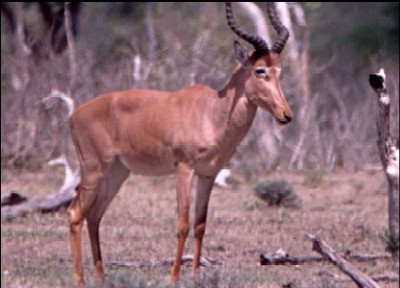
38. Greater big-footed mouse (Macrotarsomys ingens)
CRITICALLY ENDANGERED
A medium-sized mouse with large ears, long hind feet and an extremely long tail.
39. New-Guinea big-eared bat (Pharotis imogene)
CRITICALLY ENDANGERED
There have been no confirmed reports of this species since 1890.
40. Persian mole (Talpa streeti)
CRITICALLY ENDANGERED
Known from only one individual, found in an area of intensive environmental disruption and military activity.
41. Volcano rabbit (Romerolagus diazi)
ENDANGERED
This small rabbit is believed to be the most primitive of all living rabbits or hares.
42. Monito del monte (Dromiciops gliroides)
VULNERABLE
The monito del monte or "mountain monkey" is regarded by scientists as a living fossil.
43. Fossa (Cryptoprocta ferox)
ENDANGERED
Madagascar’s largest carnivore, the fossa superficially resembles a small, low-slung puma.
44. Amami rabbit (Pentalagus furnessi)
ENDANGERED
This ancient species is regarded as a ‘living fossil’. and has been declared a Japanese National Monument.
45. Hainan gymnure (Hylomys hainanensis)
ENDANGERED
This species is related to hedgehogs, although it lacks spines and looks very different.
46. Golden-rumped elephant shrew (Rhynchocyon chrysopygus)
ENDANGERED
Recent studies indicate that elephant-shrews are in fact distantly related to elephants.
47. Dinagat moonrat (Podogymnura aureospinula)
ENDANGERED
The Dinagat moonrat has stiff bristly or spiny fur on its back, making it look like its relative the hedgehog.
48. Mindanao gymnure (Podogymnura truei)
ENDANGERED
This species of moonrat is a close cousin of the hedgehog.
49. Bumblebee bat (Craseonycteris thonglongyai)
ENDANGERED
The smallest mammal in the world, this bat is roughly the same size as a large bumblebee.
50. Hairy-eared dwarf lemur (Allocebus trichotis)
ENDANGERED
This cryptic species is one of the smallest of the living primates.
51. Muennink’s spiny rat (Tokudaia muenninki)
CRITICALLY ENDANGERED
Named after the grooved spines that cover most of its body.
52. Small-toothed mole (Euroscaptor parvidens)
CRITICALLY ENDANGERED
This mole spends much of its time eating earthworms stored in its underground "pantry".
53. Dugong (Dugong dugon)
VULNERABLE
Dugongs are sometimes referred to as “sea cows” because they feed almost exclusively on sea grass.
54. Leadbeater’s possum (Gymnobelideus leadbeateri)
ENDANGERED
This Australian marsupial has been adopted as one of the faunal emblems of the state of Victoria.
55. Nimba otter-shrew (Micropotamogale lamottei)
ENDANGERED
This semi-aquatic shrew looks like an otter and has a long slender tail.
56. New Zealand lesser short-tailed bat (Mystacina tuberculata)
VULNERABLE
The world’s most terrestrial bat, this species fills the niche of mice or shrews in other parts of the world.
57. Short-tailed chinchilla (Chinchilla brevicaudata)
CRITICALLY ENDANGERED
The Chinchilla was named after the South American Chinca Indians by the Spaniards in the 1500s.
58. Malayan water shrew (Chimarrogale hantu)
CRITICALLY ENDANGERED
A relatively large shrew, which is well adapted to its semi-aquatic lifestyle.
59. Sumatran water shrew (Chimarrogale sumatrana)
CRITICALLY ENDANGERED
This poorly known water shrew is known only from a single specimen.
60. Desert dormouse (Selevinia betpakdalaensis)
ENDANGERED
This dormouse has the unusual habit of shedding the upper layers of its skin when it moults.
61. Salenski’s shrew (Soriculus salenskii)
CRITICALLY ENDANGERED
This small shrew is known only from a single specimen.
<
p>62. Saiga antelope (Saiga tatarica)
CRITICALLY ENDANGERED
One of the world’s fastest animals, the distinctive saiga can reach speeds of up to 80 km/h.
63. Maned three-toed sloth (Bradypus torquatus)
ENDANGERED
The green algae that live in the fur of sloths provide them with excellent camouflage.
64. Iranian jerboa (Allactaga firouzi)
CRITICALLY ENDANGERED
The mouse-like jerboa has very long hind legs. It can leap up to three metres in a single bound.
65. Ganges River dolphin (Platanista gangetica)
ENDANGERED
This river dolphin can detect light, but its eyes lack lenses, leaving it unable to resolve images.
66. Indus River dolphin (Platanista minor)
ENDANGERED
The local name ‘susu’ is said to refer to the noise this dolphin makes when it breathes.
67. Chacoan peccary (Catagonus wagneri)
ENDANGERED
A pig-like mammal known only from fossils until discovered alive in the 1970s.
68. Senkaku mole (Nesoscaptor uchidai)
ENDANGERED
Only one Senkaku mole has ever been captured, and very little is therefore known about the species.
69. Handley’s slender mouse opossum (Marmosops handleyi)
CRITICALLY ENDANGERED
The mouse like marsupial is threatened by habitat loss, and is only known from a single locality.
70. Long-footed potoroo (Potorous longipes)
ENDANGERED
Potoroos are small rabbit-sized kangaroos, often called ‘rat kangaroos’.
71. Philippine flying lemur (Cynocephalus volans)
VULNERABLE
Neither a true flier nor a lemur, this distinctive mammal is part of an ancient lineage of gliding mammals.
72. Inquisitive shrew-mole (Uropsilus investigator)
ENDANGERED
This primitive mole more closely resembles a shrew.
73. Chinese shrew-mole (Uropsilus soricipes)
ENDANGERED
This primitive mole’s unspecialised limbs suggest that it probably does not burrow through the soil.
74. Indian rhinoceros (Rhinoceros unicornis)
ENDANGERED
The largest of the Asian rhinos, the Indian rhinoceros can be easily identified by its armour-like skin.
75. Armenian birch mouse (Sicista armenica)
CRITICALLY ENDANGERED
Like its relatives the jumping mice and jerboas, this little mammal travels on the ground by leaping.
76. Chapa pygmy dormouse (Typhlomys chapensis)
CRITICALLY ENDANGERED
This species is not a true dormouse.
77. African elephant (Loxodonta africana)
VULNERABLE
The largest living terrestrial mammal.
78. Vaquita (Phocoena sinus)
CRITICALLY ENDANGERED
The vaquita is the world’s smallest and most endangered marine cetacean.
79. Yellow-tailed woolly monkey (Lagothrix flavicauda)
CRITICALLY ENDANGERED
This distinct species of woolly monkey was thought to be extinct until its rediscovery in 1974.
80. Mountain tapir (Tapirus pinchaque)
ENDANGERED
The mountain tapir is the smallest and most endangered of the four species of tapir.
81. Long-eared jerboa (Euchoreutes naso)
ENDANGERED
This small jumping rodent can be distinguished from other jerboas by its enormous ears.
82. Grevy’s zebra (Equus grevyi)
ENDANGERED
The largest member of the zebra family.
83. Mountain zebra (Equus zebra)
ENDANGERED
The only zebra species to possess a dewlap, or skin fold on its throat.
84. Amazonian manatee (Trichechus inunguis)
VULNERABLE
The smallest member of the manatee family.
85. Peter’s tube-nosed bat (Murina grisea)
CRITICALLY ENDANGERED
This species is known from only a single specimen, and has not been reported for more than a century.
86. Chinese dormouse (Dryomys sichuanensis)
ENDANGERED
This dormouse is active at night. It sleeps during the day in a nest hidden in a small tree.
87. Blunt-eared bat (Tomopeas ravus)
VULNERABLE
This primitive mammal is the sole representative of a subfamily of bats.
88. Blue whale (Balaenoptera musculus)
ENDANGERED
The blue whale is the largest mammal ever known to have existed.
89. Fin whale (Balaenoptera physalus)
ENDANGERED
Fin whales are the second largest mammals on earth. They are named after their large, curved dorsal fins.
90. Falanouc (Eupleres goudotii)
ENDANGERED
The falanouc can store fat in the base of its tail during the cold dry months when food is in short supply.
91. Mount Kahuzi climbing mouse (Dendromus kahuziensis)
CRITICALLY ENDANGERED
This climbing mouse posesses a remarkably long, semi-prehensile (grasping) tail.
92. Bushy-tailed opossum (Glironia venusta)
VULNERABLE
The scientific name of this medium-sized opossum roughly translates as "charming dormouse-like animal".
93. Gallagher’s free-tailed bat (Chaerephon gallagheri)
CRITICALLY ENDANGERED
This bat has a length of “free” tail which extends beyond the membrane attached between the hind legs.
94. Old World sucker-footed bat (Myzopoda aurita)
VULNERABLE
Special suction pads on its wrists and ankles allow this bat to cling to smooth leaf surfaces while roosting.
95. Malagasy giant jumping rat (Hypogeomys antimena)
ENDANGERED
Madagascar’s largest rodent can jump to a metre into the air when faced with danger.
96. Imaizumi’s horseshoe bat (Rhinolophus imaizumii)
ENDANGERED
Horseshoe bats are named after their complex horseshoe-shaped "nose-leafs".
97. Orangutan (Pongo pygmaeus)
ENDANGERED
"Orangutan" is a Malay word meaning "person of the forest".
98. Chiapan climbing-rat (Tylomys bullaris)
CRITICALLY ENDANGERED
Although it superficially resembles the black rat, these two species are in fact very distantly related.
99. Tumbala climbing-rat (Tylomys tumbalensis)
CRITICALLY ENDANGERED
This hind feet of this poorly known species are modified for climbing.
100. Setzer’s mouse-tailed dormouse (Myomimus setzeri)
ENDANGERED
This unusual dormouse has a mouse-like tail and lives on or under the ground.
About Loren Coleman
Loren Coleman is one of the world’s leading cryptozoologists, some say “the” leading living cryptozoologist. Certainly, he is acknowledged as the current living American researcher and writer who has most popularized cryptozoology in the late 20th and early 21st centuries.
Starting his fieldwork and investigations in 1960, after traveling and trekking extensively in pursuit of cryptozoological mysteries, Coleman began writing to share his experiences in 1969. An honorary member of Ivan T. Sanderson’s Society for the Investigation of the Unexplained in the 1970s, Coleman has been bestowed with similar honorary memberships of the North Idaho College Cryptozoology Club in 1983, and in subsequent years, that of the British Columbia Scientific Cryptozoology Club, CryptoSafari International, and other international organizations. He was also a Life Member and Benefactor of the International Society of Cryptozoology (now-defunct).
Loren Coleman’s daily blog, as a member of the Cryptomundo Team, served as an ongoing avenue of communication for the ever-growing body of cryptozoo news from 2005 through 2013. He returned as an infrequent contributor beginning Halloween week of 2015.
Coleman is the founder in 2003, and current director of the International Cryptozoology Museum in Portland, Maine.
Filed under Breaking News, CryptoZoo News, Cryptozoologists, Cryptozoology, Expedition Reports, Eyewitness Accounts